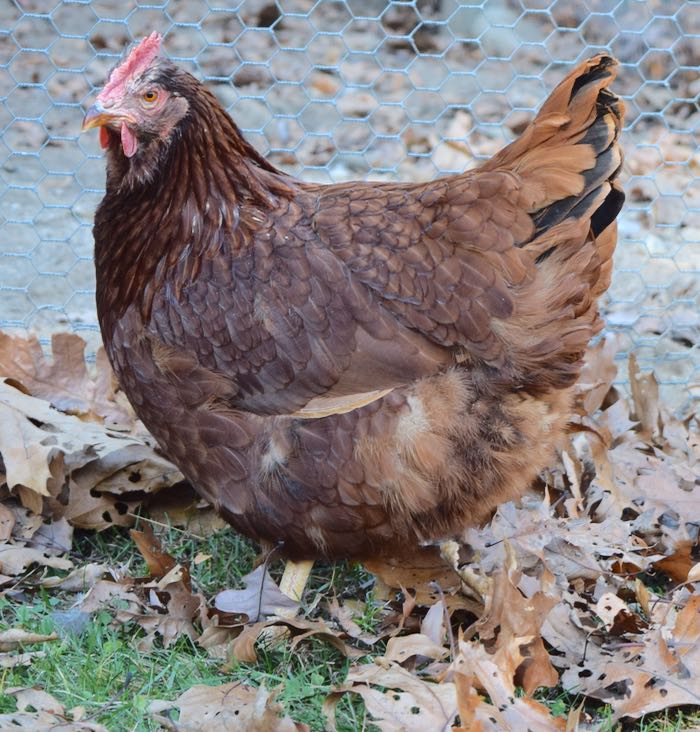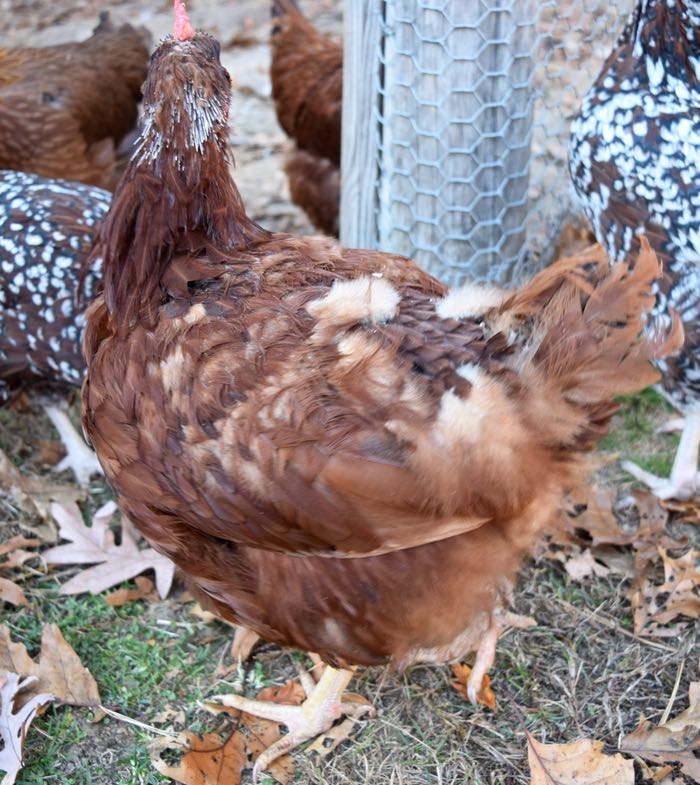The molt is triggered by numerous factors. The age of the hen and the changing season are primary instigators. The poorest layers tend to molt first. Timing of the molt is also influenced by the breed. If under great stress, or ill, chickens will molt at other times of the year.
I have two Rhode Island Reds. They are the same age, from the same hatchery, eat the same food, and live in the same coop. One is only beginning to loosen her feathers in preparation for the molt.
The other is in the midst of loosing and growing feathers at the same time.
I have no clue why these two hens are on different schedules. It might be health, or genetics, or something else. I don’t even know who’s who! One is Ruby, one is Garnet. Garnet used to have a blue band on her ankle so that I could tell them apart. That fell off. I used to be able to tell them apart by their tails, but now I can’t compare them, being as one of the chickens barely has a tail. So, I will call the molting hen Ruby. Unless one of you has been keeping track of them?



Good luck with that! There was a change over with the head henship between our two Barred Rocks but I don’t know if that was because of the molt or that I lost track of who was who!
Just FYI – there was a grey squirrel enjoying himself on the goat boys’ windowsill!
Too damp and cold for Lily to stay outside and patrol. Alas, the squirrels know her schedule.
I have 7 chickens who are all about 1 1/2 years old. The thing that I noticed is that the 2 who kept going broody this summer are the 2 who started molting first. Thank you for your advice on how to break the broody cycle, by the way. I used it and it worked!
Glad it did!
do they not anwer to their names?…or they all come runnin’?
They don’t know their names, but they know “Gems!” I rarely single them out so no need to teach their names.
The poorest layers definitely molt first, my welsummer ‘ Welly ‘ stops in August and does not start again till middle of May. She has done this for 2 years since she started laying at 24wks. This year she has only layed 60 eggs and will not lay anymore till late spring. If she wasn’t such a character I would have outed her long ago, but the way they look at you gets under your skin. I wondered if you get a runt in chickens like you do with cats and dogs….:)
Yes you do get a runt and a large one. I have had my chicken Violet to the vet before. He specializes in avian. But more importantly loves chivkens and sees a lot of them. Not every avian vet will see chickens. . AsTerry can tell you chickens are a breed apart lol. Anyway I was in the waiting room and a lady with anither hen looked at Violet and said my what a plump bird! Violet is a splash maran and very large lady! She isover 7lbs. But not fat you can feel her breast. So I asked the vet and he informed me Violet felt good, looked good etc and that some clutches can have a bigger bird ,a smaller Bird and genetics from the parents plays a part as it does with cats/ dogs. So I was very happy to know Violet isn’t fat .just a big girl . She loves my vet and actually likes to ride in the car carrier. She would much prefer to be out of the carrier at the vets and walk all around. But I can’t do that. Too much to spook her. But anyway, my Violet is rather large. i had two belgian D’uccles hatched from the same parents so were siblings. One was noticeably smaller. Weighed less. One was 24 oz. the other 20. Doesn’t sound like much but for these tiny little birds that’s quite abit. The smaller one was very spunky. Lol out of my original 9 birds she was middle of the pecking order. She was above the pecking order from the 7 lb maran , violet lol.
For my identical hens, I’ve had good luck by comparing combs. There’s always a little something different with the combs of two otherwise look-alike hens.
The bigger question for me is: how do you tell which hen lays which egg?? Easter Eggers, Leghorns, etc. are obvious, but short of sitting in my coop all day watching those slow pokes take their sweet time in the nest boxes, I can’t attach a responsible hen to any of a possible 6-8 lovely brown eggs. How do you do it, Terry?
Some hens lay eggs that are pointier than others. But a few do lay identical eggs. I have pulled up a stool and waited to see which hen lays which egg!